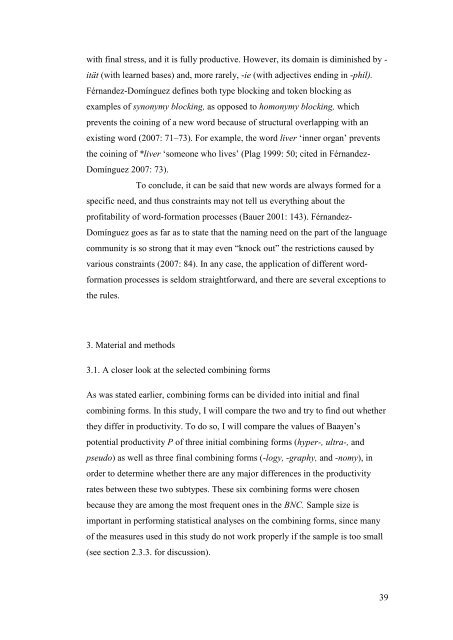The morphological productivity of selected ... - Helda - Helsinki.fi
The morphological productivity of selected ... - Helda - Helsinki.fi
The morphological productivity of selected ... - Helda - Helsinki.fi
You also want an ePaper? Increase the reach of your titles
YUMPU automatically turns print PDFs into web optimized ePapers that Google loves.
with <strong>fi</strong>nal stress, and it is fully productive. However, its domain is diminished by -<br />
ität (with learned bases) and, more rarely, -ie (with adjectives ending in -phil).<br />
Férnandez-Domínguez de<strong>fi</strong>nes both type blocking and token blocking as<br />
examples <strong>of</strong> synonymy blocking, as opposed to homonymy blocking, which<br />
prevents the coining <strong>of</strong> a new word because <strong>of</strong> structural overlapping with an<br />
existing word (2007: 71–73). For example, the word liver ‘inner organ’ prevents<br />
the coining <strong>of</strong> *liver ‘someone who lives’ (Plag 1999: 50; cited in Férnandez-<br />
Domínguez 2007: 73).<br />
To conclude, it can be said that new words are always formed for a<br />
speci<strong>fi</strong>c need, and thus constraints may not tell us everything about the<br />
pr<strong>of</strong>itability <strong>of</strong> word-formation processes (Bauer 2001: 143). Férnandez-<br />
Domínguez goes as far as to state that the naming need on the part <strong>of</strong> the language<br />
community is so strong that it may even “knock out” the restrictions caused by<br />
various constraints (2007: 84). In any case, the application <strong>of</strong> different wordformation<br />
processes is seldom straightforward, and there are several exceptions to<br />
the rules.<br />
3. Material and methods<br />
3.1. A closer look at the <strong>selected</strong> combining forms<br />
As was stated earlier, combining forms can be divided into initial and <strong>fi</strong>nal<br />
combining forms. In this study, I will compare the two and try to <strong>fi</strong>nd out whether<br />
they differ in <strong>productivity</strong>. To do so, I will compare the values <strong>of</strong> Baayen’s<br />
potential <strong>productivity</strong> P <strong>of</strong> three initial combining forms (hyper-, ultra-, and<br />
pseudo) as well as three <strong>fi</strong>nal combining forms (-logy, -graphy, and -nomy), in<br />
order to determine whether there are any major differences in the <strong>productivity</strong><br />
rates between these two subtypes. <strong>The</strong>se six combining forms were chosen<br />
because they are among the most frequent ones in the BNC. Sample size is<br />
important in performing statistical analyses on the combining forms, since many<br />
<strong>of</strong> the measures used in this study do not work properly if the sample is too small<br />
(see section 2.3.3. for discussion).<br />
39
















